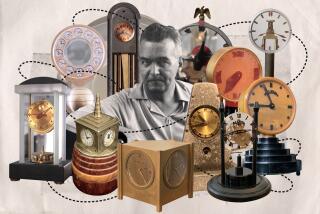Vista’s clock and watch museum is a timely addition to Southern California attractions
Reporting from Vista, Calif. — To quote the band Chicago, “Does anybody really know what time it is? Does anybody really care?”
Why, yes, we do care, especially when we get an extra hour thanks to next weekend’s time change, so go ahead and “fall back” … to sleep that is.
Or you could use that extra time on a pleasurable outing to the West Coast Clock and Watch Museum.
The exhibit is in an unusual location: a barn on the sprawling grounds of the Antique Gas & Steam Engine Museum in Vista in San Diego County.
What do timepieces have in common with hulking gas and steam engines? Well, the AG&SE’s mission is to celebrate the “art of invention fulfilling necessity.” And what could be more necessary than keeping track of time?
The West Coast Clock and Watch Museum is a relative newcomer to Southern California, moving in 2016 from its cramped space at the Old Bellingham City Hall in Bellingham, Wash. The Vista facility, although small, offers room to grow.
My husband and I recently paid the $5 admission and crossed the yard to the barn housing the single-room museum.
Docent John Ginzler greeted us. He was a genial host who was happy to show off the timepiece collection and put it in context for this pair of budding horologists.
More than 300 clocks from America and Europe are on display, some owned by the museum and others on loan from collectors. A smattering of watches also can be viewed.
As we walked around the room, Ginzler pointed out interesting examples such as French boudoir-style clocks; large, heavy tower timepieces; one he said “was the first electrical clock on the West Coast”; a zoo’s worth of novelty animal clocks; and tavern clocks (also found in churches) that had to be big enough to be read easily across a large room.
Exhibit highlights featured the oldest clock at the museum, a fairly primitive English tall-case version circa 1710 that had only an hour hand; an appealing Morbier French metal clock with gilded enamel; a snail novelty clock that Ginzler said was a joke about “how fast time goes”; a calendar clock from the mid-1800s that was selling well until it ran into a glitch — it forgot to account for Feb. 29 in leap years (the company went bankrupt); and a series of musical clocks. He demonstrated one that played a tinny version of “Auld Lang Syne.”
One of my favorites was an antique novelty clock that looked like artist Toulouse-Lautrec and had a ridiculous alarm. When it sounded, the alarm triggered a movement that struck a match that lighted the wick of a small oil lamp. The lamp would illuminate a dark room — and also burned down a few houses before the clocks were discontinued.
I also liked a clock from the 1893 Chicago World’s Fair with a Ferris wheel on top. (The fair showcased George Ferris’ original ride.)
The tour ended with an exhibit that was scandalous in its day: a clock featuring the harem pants-clad belly dancer Little Egypt, also from the 1893 Chicago fair. This piece dared to show a woman’s ankle — and only men were allowed to view it because it was considered too risqué for women to view Later, some vendors sold a souvenir miniature version deemed “safe” for women.
As Ginzler put it, “It was very much about marketing, making a buck out of everything.”
Some notions are timeless.
If you go
West Coast Clock and Watch Museum, 2040 N. Santa Fe Ave., Vista, Calif.; (760) 941-1791. Open 10 a.m.-4 p.m. daily, except Christmas and New Year’s Day.
More to Read
Sign up for The Wild
We’ll help you find the best places to hike, bike and run, as well as the perfect silent spots for meditation and yoga.
You may occasionally receive promotional content from the Los Angeles Times.






